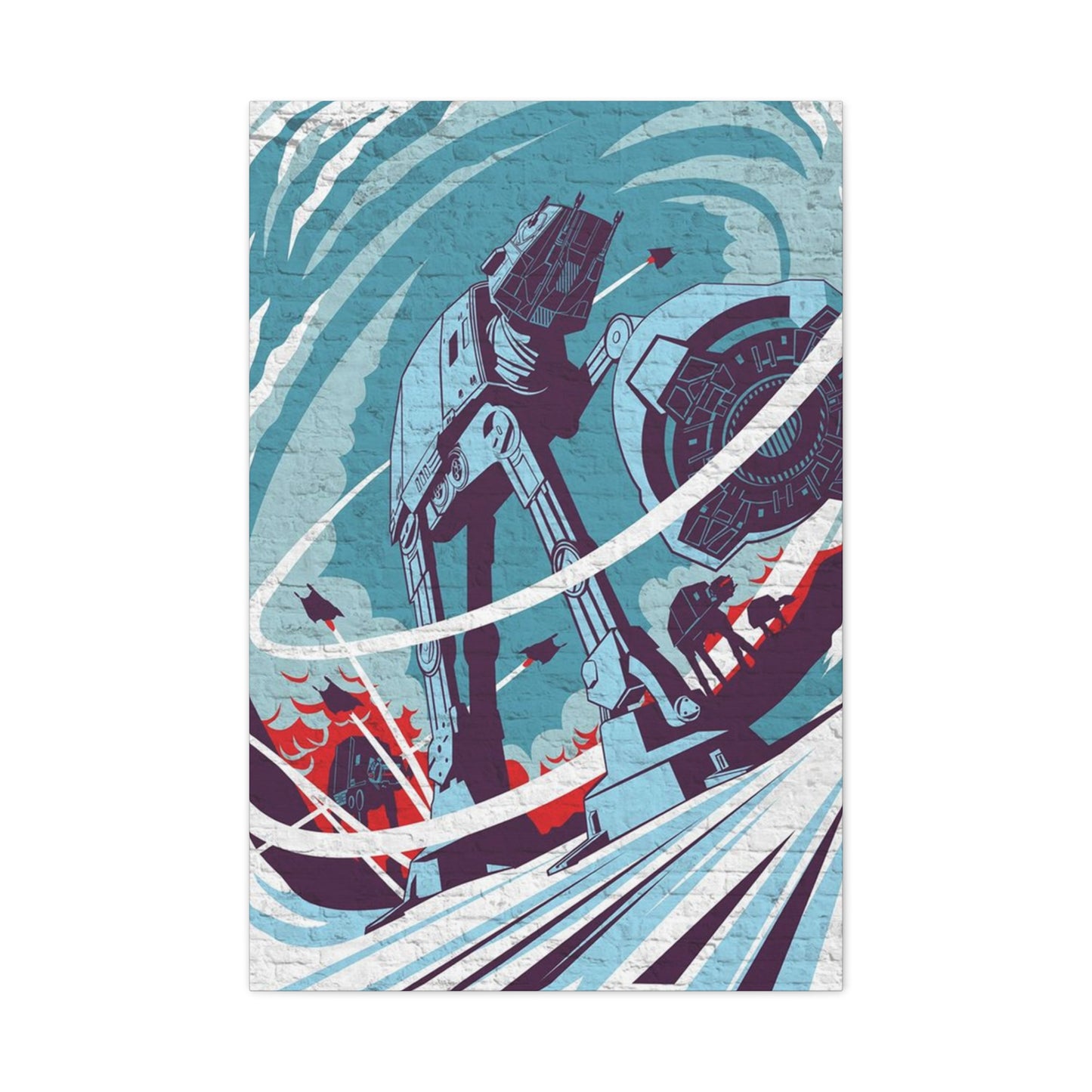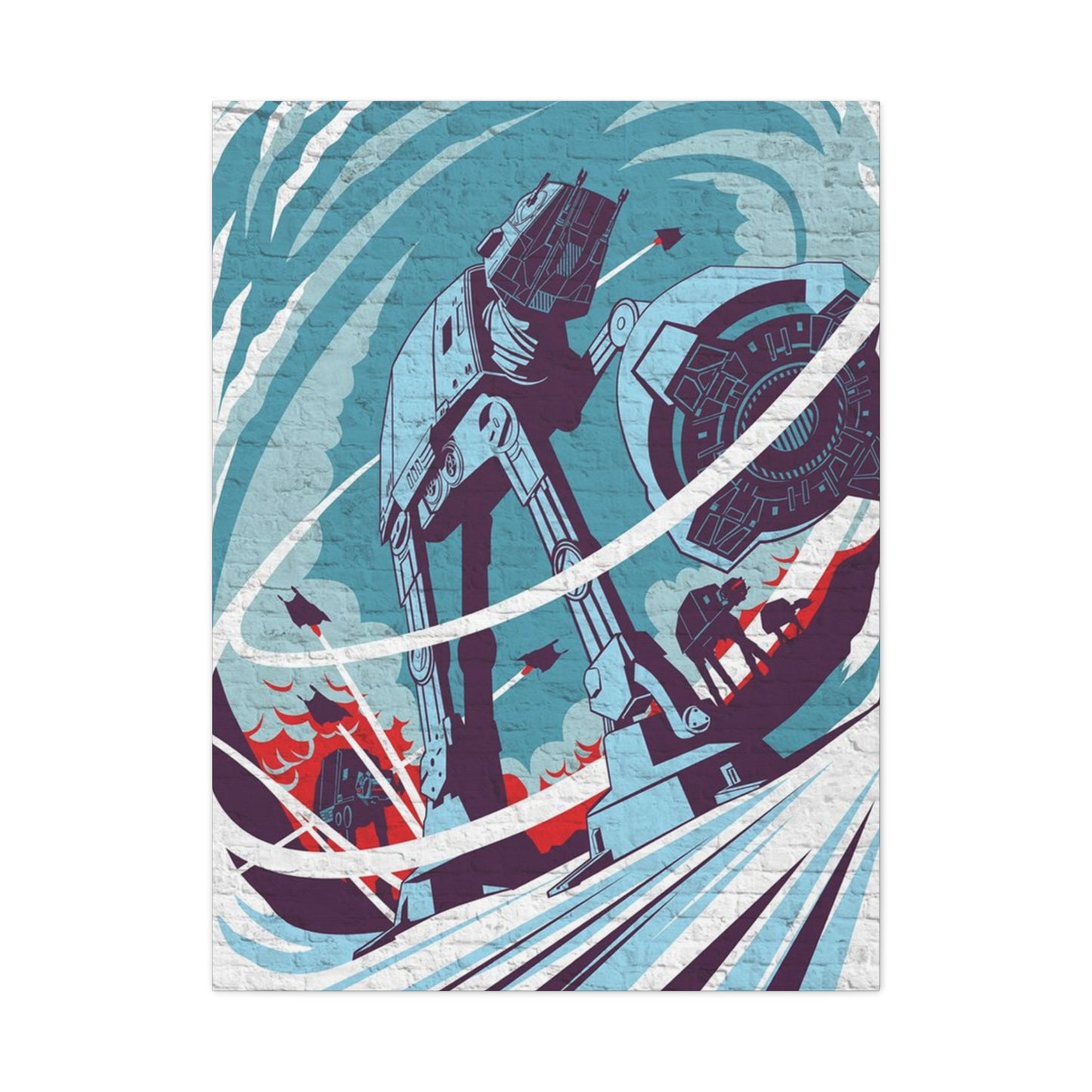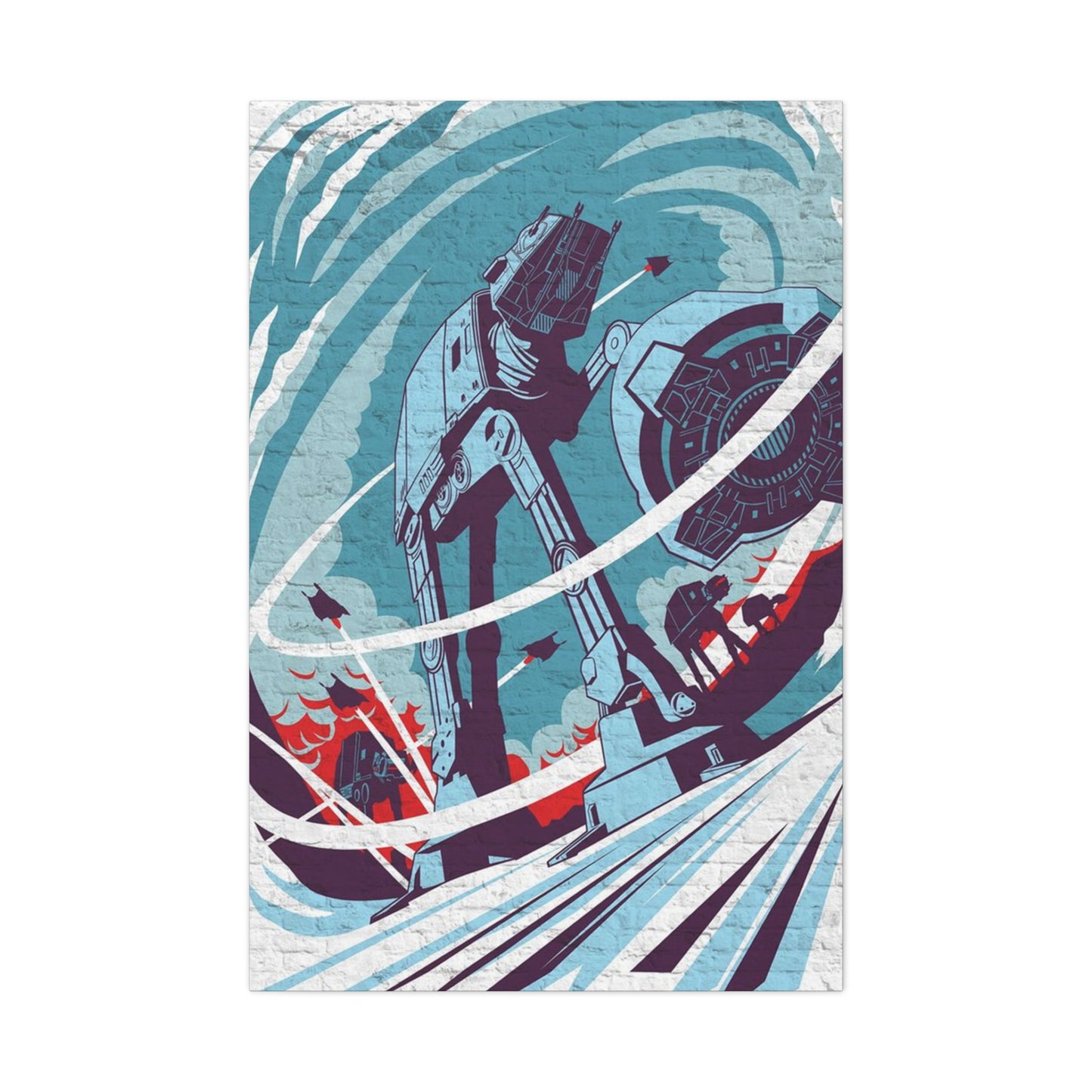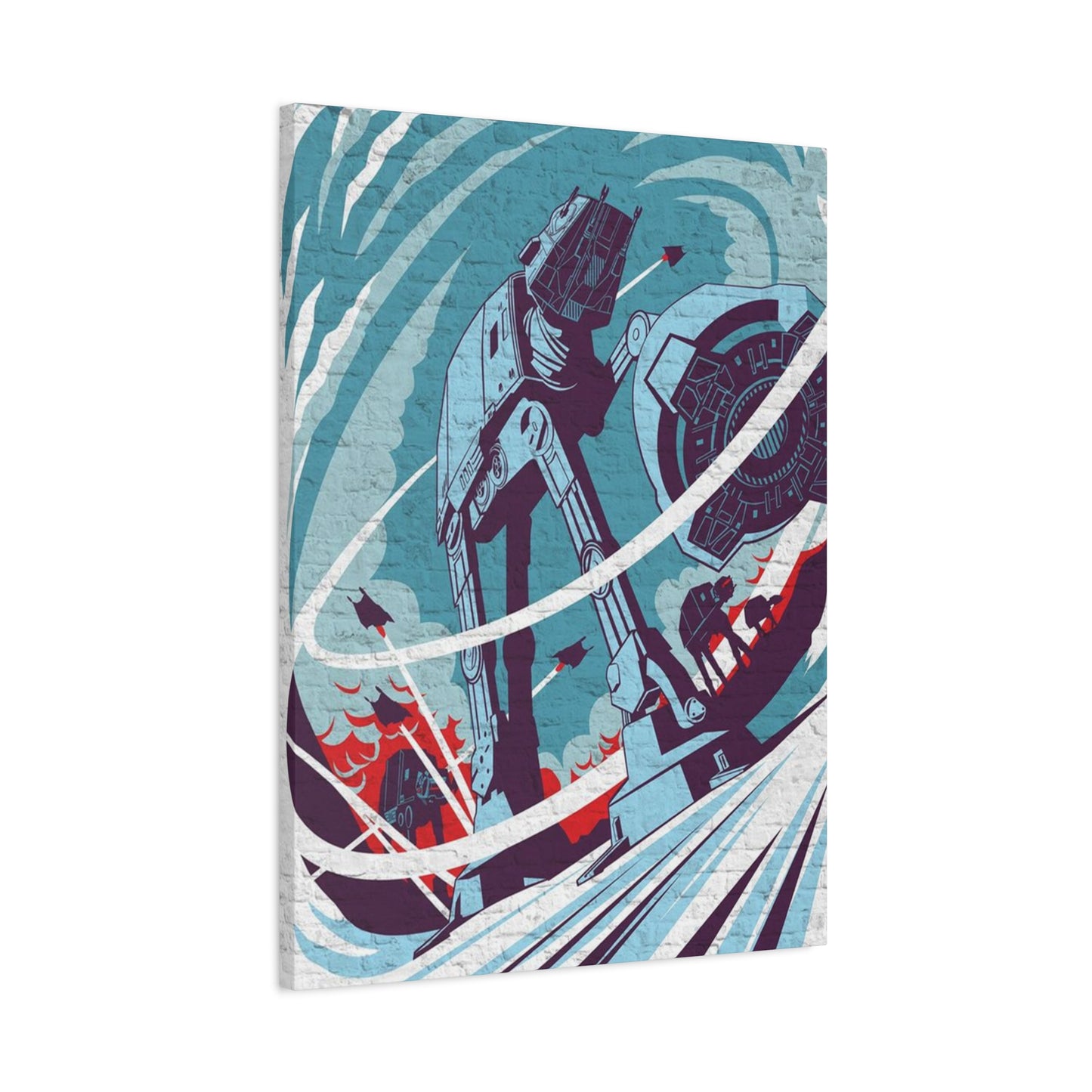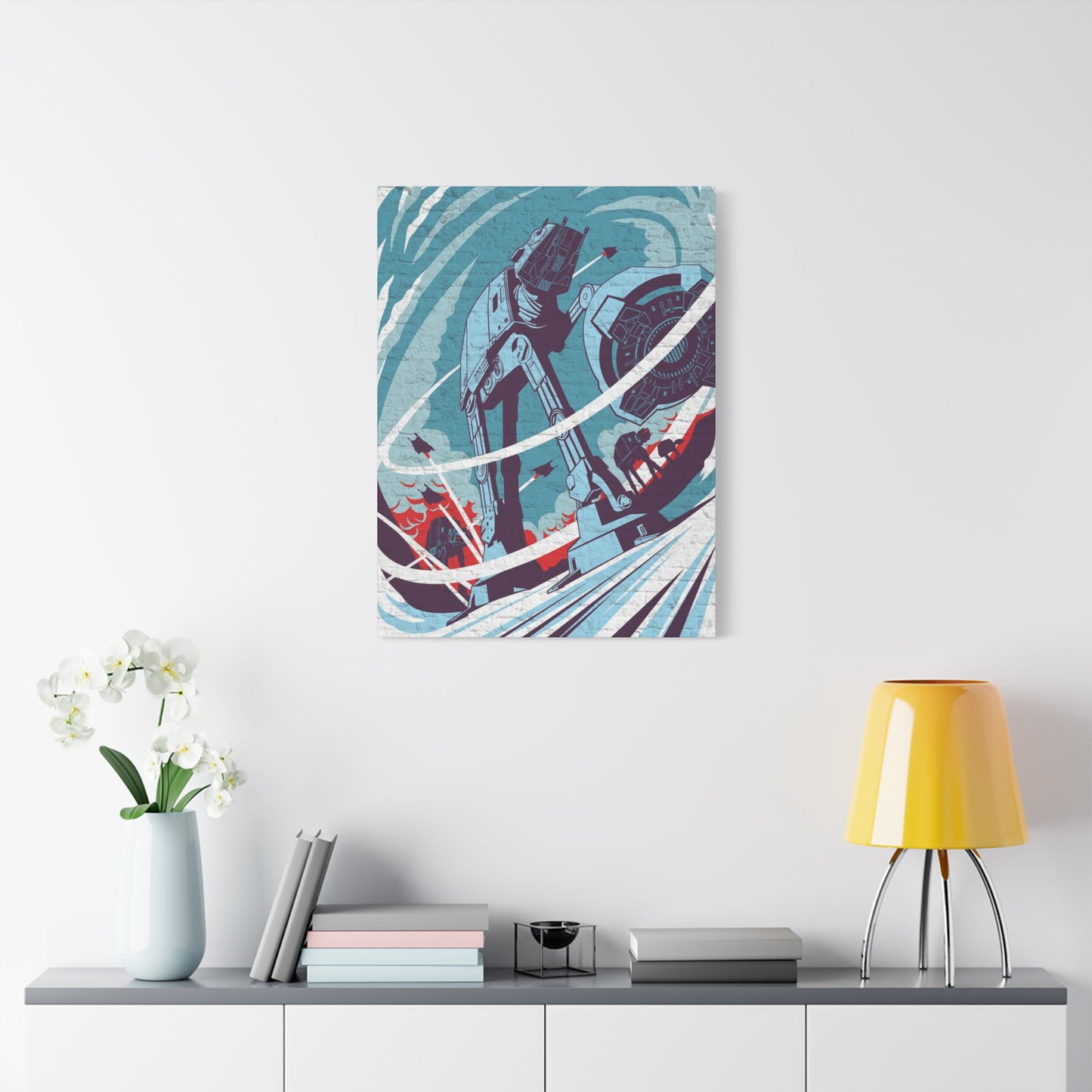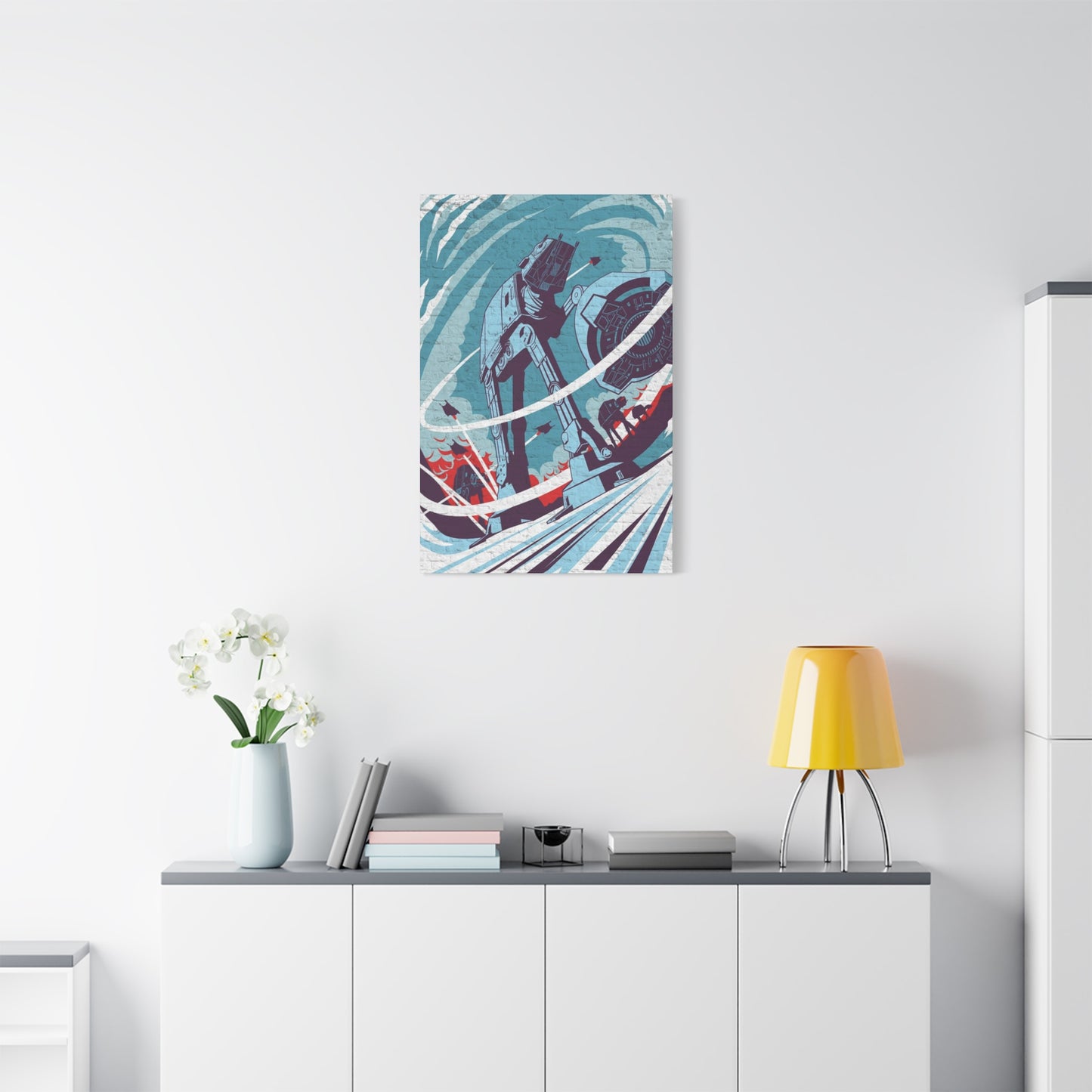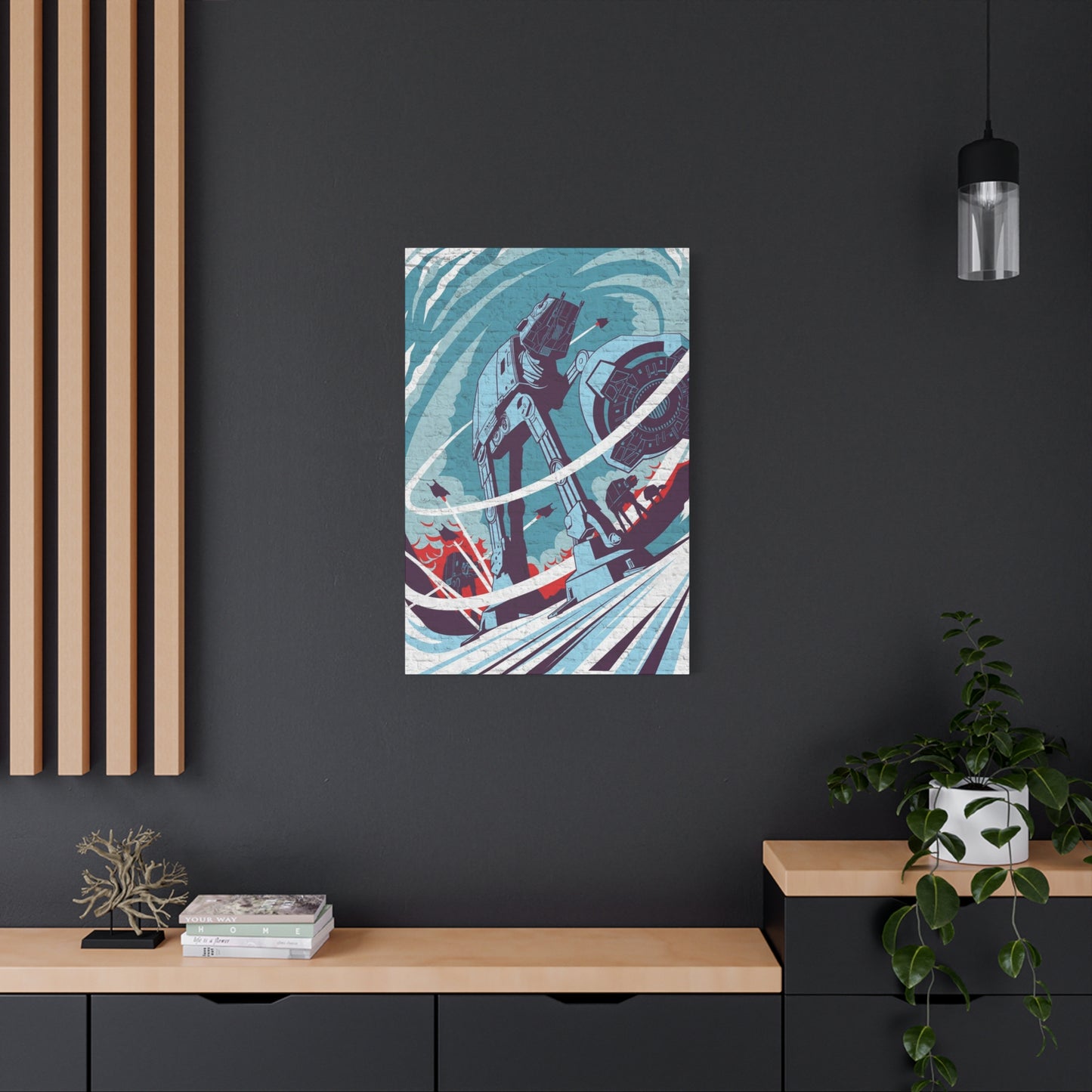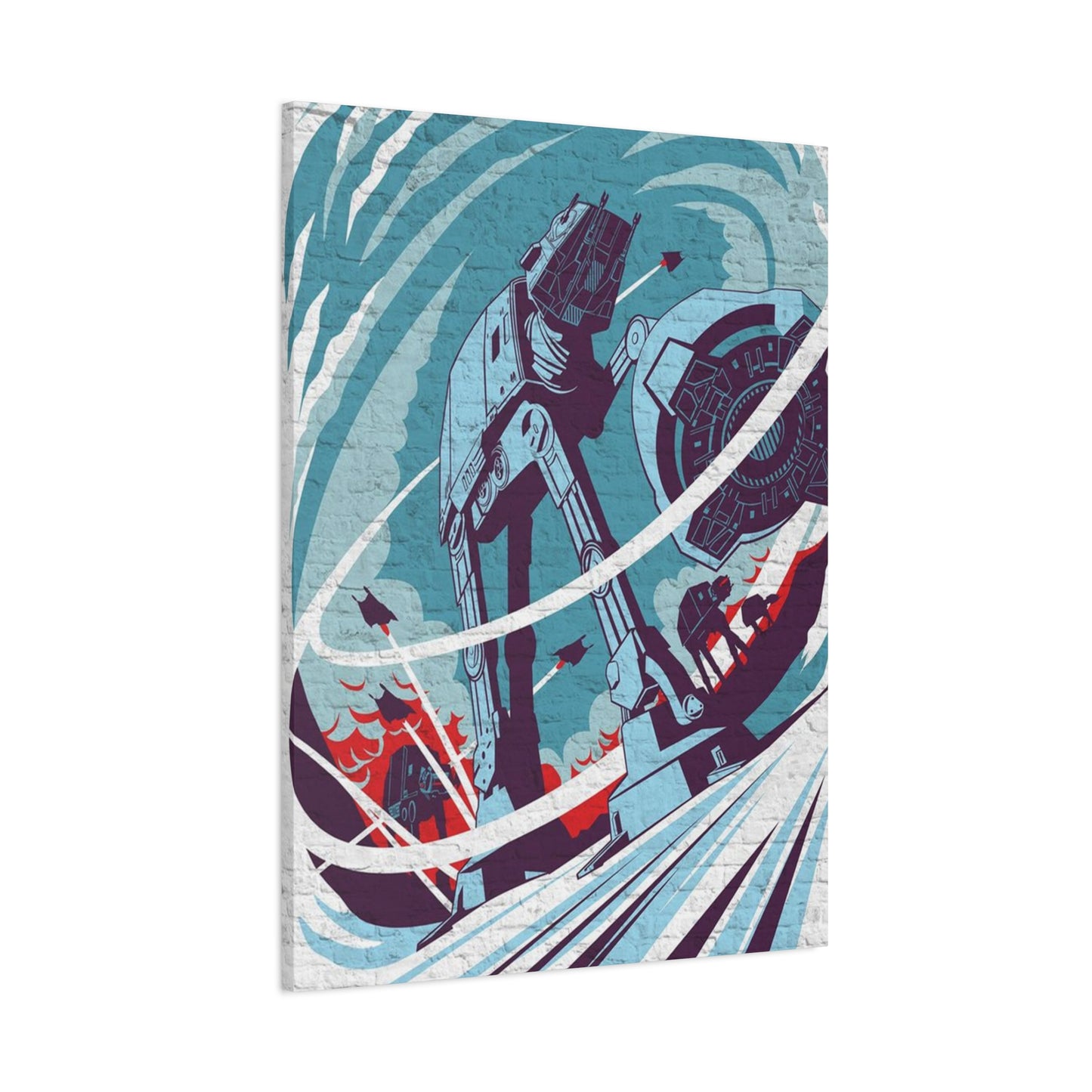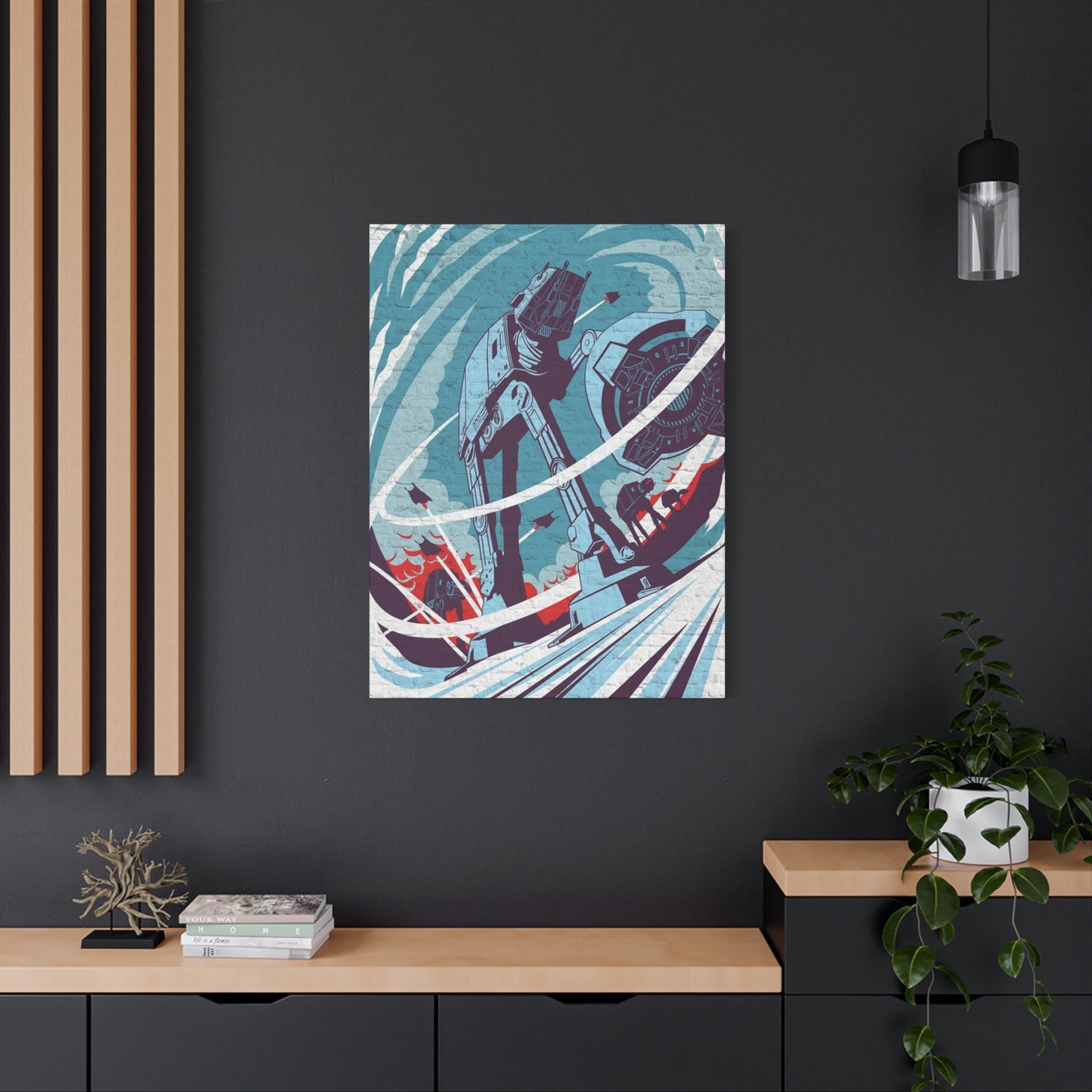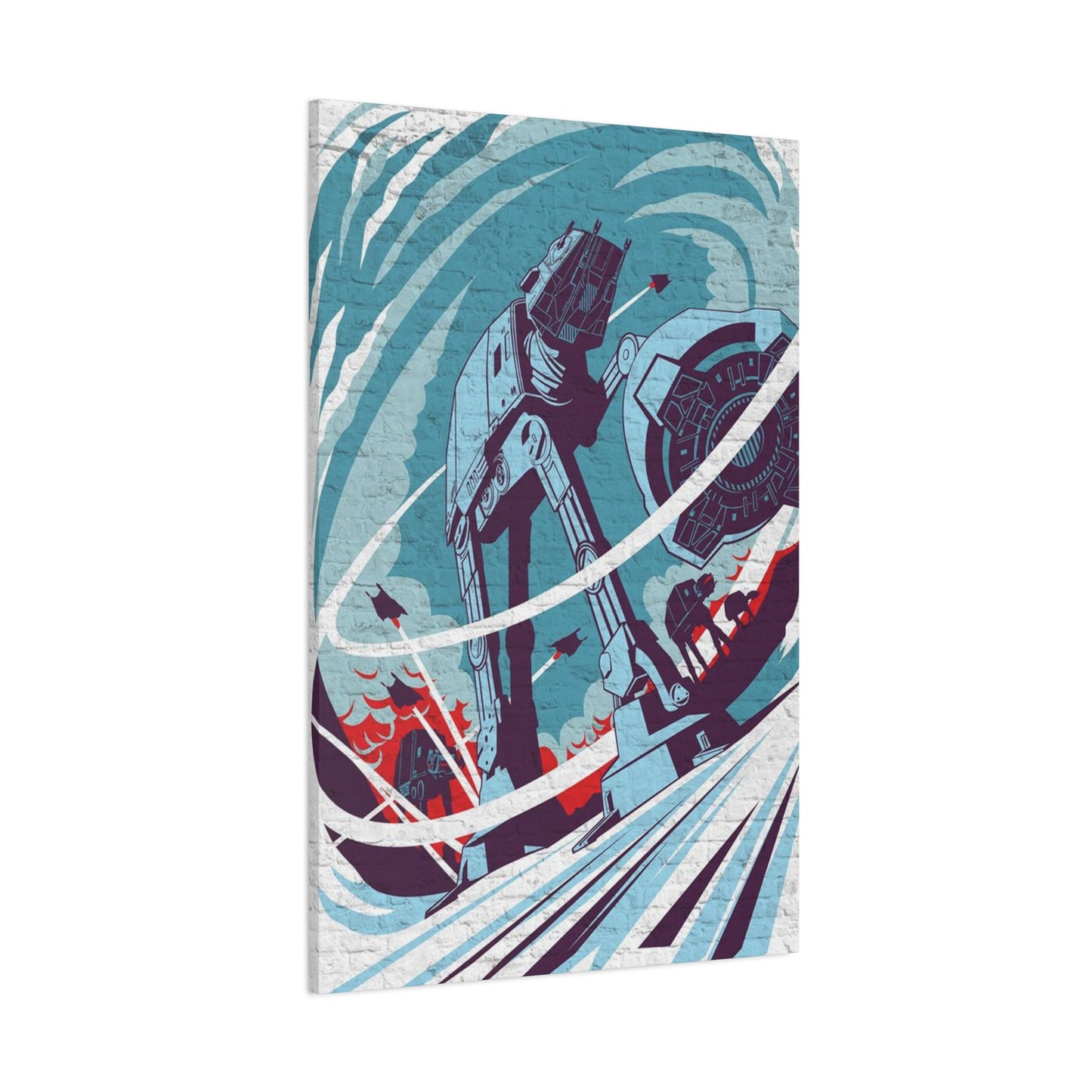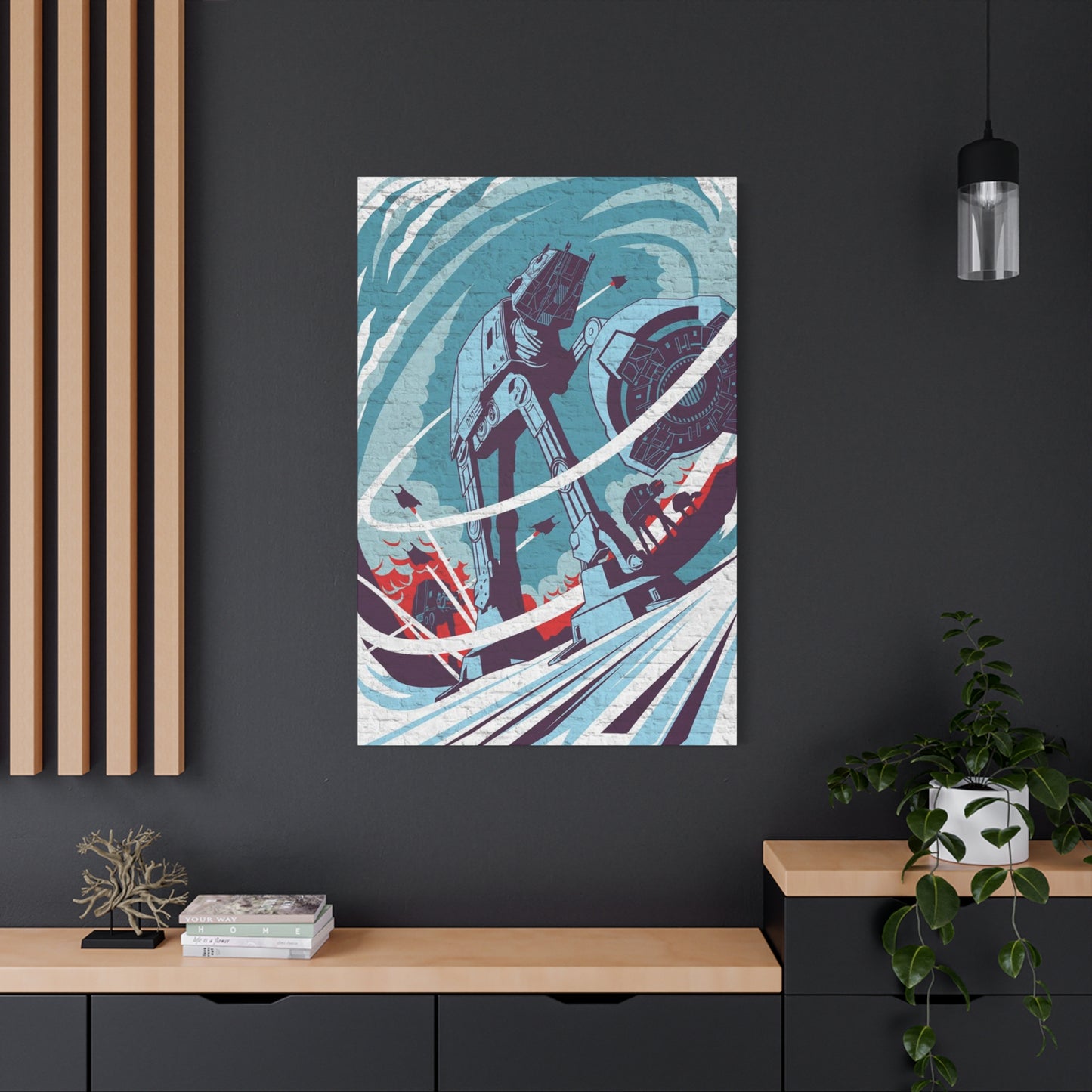The Majesty of Star Wars Machinery Wall art: Bringing Galactic Vehicles and Starships
The galaxy far, far away has captivated audiences for decades with its stunning array of technological marvels, mechanical wonders, and engineering masterpieces. From towering walkers that shake the ground with each step to sleek starfighters that pierce through the cosmos, the vehicles and machinery of Star Wars represent some of the most recognizable and beloved elements of the entire franchise. These mechanical creations have transcended their roles as mere props or background elements to become iconic symbols of adventure, rebellion, empire, and the eternal struggle between light and darkness. When translated into artistic representations for interior spaces, these mechanical marvels offer an extraordinary opportunity to infuse any environment with the excitement, nostalgia, and visual drama that defines the Star Wars universe.
The appeal of featuring these galactic machines in home decor extends far beyond simple fandom. These vehicles represent exceptional design work, combining functionality with aesthetic beauty in ways that resonate with both casual admirers and devoted enthusiasts. The clean lines of Imperial machinery, the weathered charm of Rebel Alliance equipment, and the exotic designs of various galactic cultures create a rich visual vocabulary that translates beautifully into artistic media. Whether rendered in detailed technical illustrations, dramatic action scenes, or abstract interpretations, these machines carry inherent visual power that commands attention and sparks imagination.
Interior design has evolved to embrace popular culture in increasingly sophisticated ways, and Star Wars mechanical imagery sits at the forefront of this movement. No longer relegated to children's rooms or basement gaming spaces, these artistic pieces now grace contemporary living rooms, modern offices, and stylish entertainment areas. The key lies in selecting the right representations, understanding scale and placement, and integrating these pieces thoughtfully within existing design schemes. The mechanical subjects themselves offer versatility, from the brutalist aesthetics of Imperial forces to the organic, lived-in quality of smuggler vessels and Rebel hardware.
The psychological impact of surrounding yourself with imagery from beloved narratives cannot be understated. These machines represent more than metal and circuitry; they embody stories of heroism, adventure, and triumph against overwhelming odds. A well-placed artistic representation of an X-wing fighter or Star Destroyer creates an instant emotional connection, transporting viewers back to memorable moments from films, television series, books, and games. This emotional resonance transforms a simple decorative choice into a daily source of inspiration and joy.
From a design perspective, Star Wars machinery offers remarkable diversity in form, color, and composition. The franchise spans multiple eras, each with distinct visual characteristics and design philosophies. The sleek, chrome-finished vessels of Naboo contrast sharply with the weathered, utilitarian craft of Tatooine. The massive, wedge-shaped Imperial warships create dramatically different visual statements compared to the organic, flowing lines of Mon Calamari cruisers. This variety ensures that regardless of personal taste or existing decor style, there exists a perfect mechanical subject to complement and enhance any space.
The technical artistry involved in creating these fictional machines deserves recognition as well. Concept artists, model makers, and digital designers have poured countless hours into developing vehicles that feel simultaneously fantastical and believable. Every panel, weapon system, engine component, and structural element serves both narrative and aesthetic purposes. When these designs are captured in artistic prints, paintings, or other wall-mounted formats, they showcase not just the fictional technology but also the real-world creativity and skill that brought them to life.
Exploring Star Wars Machinery Across the Galactic Spectrum
The Star Wars universe presents an astonishing array of vehicles and machines, each designed to serve specific functions within their fictional contexts while simultaneously capturing the imagination of audiences. Understanding this diversity helps in selecting pieces that will resonate most strongly with personal preferences and design objectives. The machinery spans multiple categories, from personal transport to capital ships capable of carrying thousands, from atmospheric craft to vessels designed for the vacuum of space, from combat-oriented designs to civilian transports.
Ground vehicles represent some of the most immediately recognizable machines in the franchise. The All Terrain Armored Transport, commonly known as the AT-AT, stands as perhaps the most iconic ground vehicle ever conceived for science fiction. These massive four-legged walkers embody Imperial might and technological superiority, their towering forms designed to intimidate as much as to transport troops. The mechanical complexity of their articulated legs, the imposing command pod suspended high above the battlefield, and the heavy armor plating create a subject rich with visual interest. Artistic representations of AT-ATs work exceptionally well in larger formats where their scale and presence can be fully appreciated. Whether depicted mid-stride across snowy terrain or standing sentinel over conquered territories, these machines convey power and drama.
The AT-ST, or All Terrain Scout Transport, offers a more compact alternative while maintaining the distinctive walker aesthetic. These two-legged reconnaissance vehicles possess an almost bird-like quality in their movement and stance, creating dynamic possibilities for artistic composition. Their smaller scale and more nimble appearance make them suitable subjects for various room sizes and design schemes. Artists often capture them in action-oriented poses, navigating forest terrain or engaging with Rebel forces, creating pieces that feel energetic and alive.
Speeder bikes represent velocity and maneuverability in their purest forms. These personal transport vehicles, featured memorably in high-speed chases through forest environments, embody grace and danger simultaneously. The sleek, elongated design with its prominent forward vanes creates striking silhouettes that work beautifully in horizontal compositions. Artistic interpretations of speeder bikes can range from technical cutaway illustrations showing their internal mechanics to motion-blurred action scenes that emphasize their incredible speed. The relatively simple form of these vehicles makes them versatile subjects that can complement modern, minimalist design schemes while still maintaining their Star Wars identity.
Atmospheric fighters form another crucial category of Star Wars machinery. The T-65 X-wing starfighter stands as the quintessential symbol of the Rebel Alliance, its distinctive S-foil wings creating an immediately recognizable profile. The X-wing represents hope, rebellion, and the triumph of skilled pilots over superior numbers. Its design balances aggression with elegance, featuring proportions that feel both powerful and graceful. Wall art featuring X-wings benefits from their strong geometric shapes, whether captured in flight formation, banking through canyons, or locked in combat. The surface details of these fighters, from scoring on their hulls to colorful squadron markings, provide additional visual interest that rewards closer inspection.
The TIE fighter represents the Imperial counterpoint to Rebel starfighters. With its distinctive hexagonal solar panels flanking a spherical cockpit pod, the TIE fighter projects menace through stark, efficient design. The monochromatic color scheme of most Imperial TIE variants lends itself well to dramatic lighting and shadow work in artistic representations. The sound of TIE fighter engines has become as iconic as their appearance, and quality artwork can almost evoke that screaming roar visually through composition and energy. Displaying TIE fighters in wall art creates an immediate association with the Empire's vast military might and the faceless precision of Imperial forces.
The A-wing interceptor showcases Rebel ingenuity in creating vessels that could outmaneuver larger, more heavily armed opponents. Its wedge-shaped profile and prominent engines create a sense of barely-contained speed even in static representations. The vibrant colors often associated with A-wing squadrons, particularly the reds and greens of their markings, add welcome splashes of color to artistic pieces. These nimble craft work particularly well in diagonal compositions that emphasize their velocity and agility.
Bombers and heavy assault craft provide different aesthetic opportunities. The Y-wing, with its exposed engines and stripped-down appearance, tells stories of hard service and utilitarian functionality. These vessels rarely receive the glamorous attention given to fighters, yet their weathered, mechanical complexity makes them fascinating subjects for detailed technical artwork. The asymmetrical design of B-wing starfighters creates unusual and eye-catching silhouettes that challenge conventional composition while remaining undeniably Star Wars in character.
Capital ships and space stations occupy the largest scale of Star Wars machinery. The Imperial Star Destroyer stands as one of the most imposing vessel designs in science fiction history. The massive wedge-shaped hull, bristling with weapon emplacements and sensor arrays, communicates absolute dominance. The sheer scale of these vessels, measuring over a mile in length, creates opportunities for artwork that emphasizes their overwhelming size. Compositions that show Star Destroyers from below, their hulls filling the frame and extending beyond the edges, create powerful statements about Imperial power. The intricate surface details of these vessels reward large-format presentations where viewers can appreciate the complexity of their construction.
The Executor-class Super Star Destroyer takes the intimidation factor even further, dwarfing standard Star Destroyers with its multi-mile length and city-like superstructure. Artistic representations of these behemoths work best when context establishes their scale, perhaps showing smaller vessels nearby for comparison. The command tower rising from the dorsal surface creates interesting vertical elements in compositions that might otherwise be dominated by horizontal lines.
Mon Calamari cruisers represent the organic design philosophy of the Rebel Alliance capital ships. These vessels, converted from civilian star liners, feature flowing, bubble-like hull sections that contrast dramatically with the angular Imperial aesthetic. The warm colors of their hulls, ranging from salmon to rust-red, create visual warmth in artistic representations. These ships tell stories of improvisation and determination, of a Rebel fleet assembled from whatever vessels could be spared or captured.
The Millennium Falcon deserves special recognition as perhaps the most beloved spacecraft in cinematic history. This modified YT-1300 light freighter combines an instantly recognizable circular hull with asymmetric cockpit placement and distinctive mandible-like forward extensions. The Falcon represents the underdog spirit, the maverick who plays by their own rules, and the idea that heart matters more than appearance. Countless hours of screen time have made every detail of this vessel familiar to fans, from the rectangular sensor dish to the offset cockpit to the weathered, repaired hull plating. Artistic representations of the Falcon can range from hero shots showing the ship in pristine condition to more atmospheric pieces that capture its lived-in, constantly-modified nature. The vessel works equally well as the central focus of a composition or as part of larger scenes showing multiple ships or action sequences.
Specialty vessels add even more variety to the Star Wars mechanical catalog. Slave I, the personal ship of legendary bounty hunter Boba Fett, features an unusual vertical orientation and predatory appearance that makes it instantly recognizable. Transports like the Rebel Blockade Runner, with its distinctive hammerhead bow and extended main hull, provide different silhouettes and compositional opportunities. Lambda-class shuttles, with their tri-wing configuration, represent Imperial elegance and ceremonial function.
The Death Star, while technically a space station rather than a vehicle, represents the ultimate expression of Imperial engineering and ideology. The planet-destroying battle station's spherical form, marked by its distinctive superlaser dish and complex surface detailing, creates an unmistakable icon of power and terror. Artistic representations often show the Death Star looming over planets or fleets, emphasizing its enormous scale and destructive capability. The second Death Star, partially constructed, offers additional visual interest through its incomplete superstructure and exposed internal frameworks.
Prequel-era vehicles expand the design vocabulary even further. The sleek, chrome-finished starships of Naboo present an aesthetic of elegance and refinement. Jedi starfighters, with their elongated profiles and distinctive color schemes, represent warrior monks adapted to galactic conflict. The droid armies of the Separatists introduce mechanical soldiers and spider-like walkers that create very different visual impressions from their Galactic Civil War counterparts.
The sequel trilogy introduced new mechanical designs that honor classic aesthetics while pushing into fresh territory. First Order TIE fighters maintain the hexagonal wing panels but add red accenting and updated details. Resistance X-wings continue the lineage of their Rebel predecessors with refined profiles and updated technology visible in their designs. The massive Dreadnoughts and mobile siege platforms demonstrate escalating scale and destructive capacity.
Television series have contributed their own beloved machines to the canon. The distinctive starfighter of Din Djarin, converted from a Naboo N-1, combines sleek elegance with visible modifications that tell stories of personalization and adaptation. The experimental TIE Defender, with its three wings and enhanced capabilities, represents Imperial research into superior starfighter design. The Ghost, home to the crew of Rebel agents, showcases the VCX-100 light freighter design with its distinctive nose and attached Phantom shuttle.
Each of these machines, from the smallest speeder to the largest battle station, carries decades of storytelling weight and emotional resonance. They represent not just technological speculation but cultural touchstones that span generations of fans. Selecting which machines to feature in wall art becomes an exercise in personal connection, identifying which designs speak most strongly to individual experiences and preferences.
Creating Visual Harmony with Galactic Machinery in Interior Environments
Successfully incorporating Star Wars mechanical artwork into living spaces requires thoughtful consideration of multiple factors, from room function to existing design elements to the emotional atmosphere you wish to create. The goal extends beyond simply hanging posters or prints; it involves creating cohesive environments where these pieces enhance rather than overwhelm, where they contribute to the overall design narrative rather than fighting against it.
Color palette consideration forms the foundation of successful integration. Star Wars machinery spans an impressive range of colorways, from the stark blacks, whites, and grays of Imperial forces to the warmer tones of Rebel equipment to the vibrant hues of specialized vessels and exotic craft. Understanding the existing color scheme of your space guides selection toward pieces that will harmonize or provide calculated contrast. A room dominated by cool grays and blues naturally accommodates Imperial imagery, where the monochromatic palette and angular designs complement modern, minimalist aesthetics. Conversely, spaces featuring warmer earth tones and organic textures might better suit Rebel Alliance craft with their weathered surfaces and more varied color treatments.
Strategic contrast can create powerful focal points. In a neutral-toned room, a vibrant piece featuring the bold oranges of Rebel pilot flight suits or the distinctive red markings of elite squadrons draws the eye and energizes the space. However, this approach requires restraint; too many competing colors create visual chaos rather than dynamic interest. Consider the artwork as one element in a larger composition that includes furniture, textiles, and decorative objects. The piece should feel like it belongs rather than appearing as an afterthought or incongruous addition.
Scale relationships prove crucial in determining visual impact and appropriateness. The actual size of the depicted subject matters less than how the artwork relates to its surroundings. A massive piece showing a detailed close-up of a TIE fighter panel can work beautifully above a sofa, creating intimacy with the mechanical details while providing sufficient visual weight to anchor the seating area. Alternatively, a smaller piece showing an entire fleet engagement might work perfectly in a gallery wall arrangement or as part of a symmetrical display. The key involves matching the artwork's physical dimensions and compositional scale to the wall space and surrounding elements.
Large, singular pieces create dramatic statements and serve as room focal points. A six-foot-wide canvas depicting a Star Destroyer emerging from hyperspace commands attention and sets the tone for an entire space. Such pieces work best on walls with minimal competition, where they can breathe and viewers can appreciate them from various distances. Living rooms, home theaters, and gaming spaces often provide ideal settings for these statement pieces, where their size and drama align with the room's entertainment or relaxation function.
Gallery walls and arranged groupings offer different possibilities, allowing for thematic collections or visual storytelling. A wall featuring multiple smaller pieces showing various Rebel starfighters creates a sense of a fighter squadron, with each ship maintaining its individual identity while contributing to a larger whole. This approach works particularly well in home offices, hallways, or casual spaces where viewers might spend time examining individual pieces. Maintaining consistent framing, matting, or mounting styles helps unify the collection while allowing the subject matter to vary.
Vertical spaces such as tall walls in stairwells or rooms with high ceilings call for different approaches. Vertical compositions showing vessels in climbing or diving attitudes, or arrangements that stack multiple pieces vertically, make effective use of these challenging spaces. The vertical orientation of certain ships, like Slave I in its distinctive flight mode or Lambda shuttles during landing approach, provides natural subjects for these applications.
Room function influences artwork selection in significant ways. Home theaters and entertainment rooms naturally accommodate more dramatic, action-oriented pieces showing space battles or atmospheric chase sequences. The excitement and energy of these compositions align with the room's recreational purpose. The subdued lighting typical of these spaces also benefits from artwork featuring dramatic lighting effects, glowing engines, or weapon fire that appears to illuminate the scene. Consider pieces with strong contrast and clear subjects that remain visible and impressive even in reduced light.
Home offices balance professional atmosphere with personal interest, making them ideal for more technical or analytical representations of Star Wars machinery. Cutaway illustrations showing internal systems, blueprint-style technical drawings, or detailed profile views communicate sophistication and attention to detail. These pieces satisfy fan interest while maintaining a somewhat professional appearance appropriate to work environments. The colors in these technical pieces often trend toward neutral backgrounds with strategic color accents, making them easy to integrate into traditional office palettes.
Bedrooms invite more personal, emotionally resonant selections. The Millennium Falcon might represent childhood dreams of adventure for one person, while a formation of X-wings symbolizes hope and heroism for another. These spaces allow for purely preference-driven choices without the need to consider guest impressions or maintain professional appearances. Bedroom lighting, typically softer and more variable than in common areas, affects how artwork appears throughout the day. Consider this when selecting pieces, perhaps opting for subjects with strong silhouettes that read well in various lighting conditions.
Children's rooms present opportunities for more playful, colorful representations while still honoring the source material. Younger fans might respond most strongly to bright, cartoon-style interpretations or scenes showing their favorite characters alongside memorable machines. However, many parents prefer selections that can grow with the child, choosing quality artistic representations that remain appropriate and appreciated as tastes mature. The distinction between childish and childlike matters here; well-executed artwork celebrating Star Wars machinery transcends age appropriateness while still delighting younger viewers.
Dedicated fan spaces, whether they're collections rooms, gaming areas, or Star Wars shrines, operate under different rules entirely. These environments celebrate obsession in the best possible way, where more definitely qualifies as more. Here, walls might feature dozens of pieces creating immersive environments that transport visitors into the galaxy far, far away. Mixing media, scales, and styles becomes not just acceptable but desirable, creating visual richness and giving viewers multiple entry points into the space.
Lighting design dramatically affects how mechanical artwork presents itself. Natural light brings out subtle color variations and surface textures in prints and paintings but can also cause fading over time with prolonged exposure. UV-protective glazing on framed pieces helps mitigate damage while allowing you to position artwork where natural light creates beautiful effects. Morning light streaming across a piece depicting dawn breaking over a Rebel base, or afternoon sun highlighting the metallic surfaces of an Imperial fleet, creates temporary magic that rewards thoughtful placement.
Artificial lighting offers more control and drama. Track lighting allows for precise highlighting of individual pieces or gallery walls, creating pools of illumination that draw attention and create gallery-like atmospheres. The directionality of track lights can emphasize texture in canvas prints or eliminate glare from glazed frames. Picture lights mounted directly on or above frames provide elegant, focused illumination that makes the artwork itself appear to glow. For pieces depicting subjects with prominent lighting elements like engine glow or weapon fire, careful lighting can enhance these effects, making them appear more luminous and dynamic.
Ambient lighting sets overall mood and affects how all room elements, including artwork, coexist. Warm ambient lighting tends to make spaces feel more comfortable and relaxed, potentially softening the sometimes stark appearance of Imperial machinery while enhancing the warmer tones of Rebel craft. Cooler lighting creates more modern, energetic environments that can make highly detailed technical pieces more readable and give metallic subjects additional perceived sheen.
Texture considerations extend beyond the artwork itself to surrounding elements. Smooth, glossy furniture surfaces create different relationships with machinery artwork than do rough, natural materials like exposed brick or weathered wood. Industrial design elements like metal shelving, concrete surfaces, or exposed ductwork can beautifully complement the mechanical subjects in Star Wars imagery, creating thematic harmony between the artwork and its environment. Conversely, placing these pieces in contexts featuring soft textiles, organic shapes, and natural materials creates interesting contrasts that can make both the artwork and surroundings more interesting through juxtaposition.
Furniture arrangement often centers on or responds to significant wall art. A large piece depicting a Star Destroyer logically anchors a seating arrangement, becoming the visual terminus that organizes the space. Conversation areas naturally orient toward impressive artwork, making it part of the social experience of the room. In dining areas, carefully chosen pieces provide conversation starters and enhance the atmospheric experience of meals shared with fellow fans.
Negative space, the empty wall area surrounding artwork, deserves as much consideration as the piece itself. Crowding diminishes impact; allowing breathing room lets the eye rest and prevents visual overwhelm. This principle applies especially to complex pieces showing detailed mechanical subjects or multi-ship compositions. The artwork needs space to exist as a distinct element rather than competing with immediately adjacent objects, furniture, or additional artwork.
Artistic Interpretations Celebrating Vehicles and Mechanical Marvels
The translation of Star Wars machinery from three-dimensional designs to two-dimensional artwork involves countless creative decisions that affect the final piece's character, appeal, and suitability for different spaces and tastes. Understanding these artistic approaches helps in selecting pieces that align with personal preferences and design objectives while appreciating the skill and choices that went into their creation.
Photorealistic digital artwork represents perhaps the most technically demanding approach, striving to depict these fictional machines with such fidelity that they appear to be photographs of real objects. Artists working in this style meticulously render every surface detail, weather pattern, and lighting effect to create images of startling believability. These pieces often show subjects in dramatic contexts, with atmospheric effects, dynamic lighting, and environmental elements that enhance the sense of reality. The technical precision appeals to viewers who want to feel fully immersed in the Star Wars universe, to see these machines as tangible objects rather than fantasy concepts.
The level of detail in photorealistic work rewards close examination. Surface weathering tells stories of hard service and combat experience. Carbon scoring from near-misses with blaster fire, scored paint revealing bare metal beneath, hydraulic staining around moving parts, and the subtle variations in surface cleanliness across a hull all contribute to believability. Artists who excel in this style understand not just how things look but how they would logically show wear based on function and environment. An X-wing fresh from the factory appears very different from one that has seen months of combat operations, and quality photorealistic artwork captures these distinctions.
Lighting plays an enormous role in photorealistic pieces. The warm glow of engine thrust, the cool blue of hyperspace tunnel walls, the harsh illumination of flares and explosions, or the subtle ambient light within massive hangar bays all require technical understanding and artistic skill to execute convincingly. The way light interacts with different materials, reflecting sharply off polished metal while absorbing into rubberized surfaces or translucent canopies, adds layers of visual complexity that make the artwork feel substantial and real.
Traditional painting techniques offer very different aesthetic qualities. Oil paintings of Star Wars machinery can emphasize texture and visible brushwork, celebrating the artist's hand in creating the image. This approach shifts focus slightly from pure representation toward artistic interpretation, where the subject matter combines with the physical qualities of the medium itself. Thick impasto technique creates actual three-dimensional texture on the canvas surface, catching light and casting tiny shadows that change the appearance as viewing angles shift. Looser, more impressionistic painting styles capture the essence and energy of subjects without getting mired in mechanical minutiae, resulting in pieces that feel dynamic and alive.
Watercolor techniques bring their own particular magic to mechanical subjects. The fluid, translucent qualities of watercolor might seem at odds with hard-edged machinery, yet skilled artists exploit this tension to create pieces of unusual beauty. Soft color washes suggest atmospheric conditions, depth, and motion, while tighter detail work defines key elements and maintains recognizability. The unpredictability inherent in watercolor can introduce happy accidents that add character and uniqueness to each piece, making original watercolor paintings particularly special additions to collections.
Vector illustration and graphic design approaches simplify and stylize, reducing subjects to essential shapes and colors while maintaining clear identity. These pieces work exceptionally well in modern, minimalist environments where simplified aesthetics dominate. The clean lines and flat colors of vector work complement contemporary design while still communicating clear Star Wars content. Poster-style compositions using limited color palettes create striking visual impact through bold shapes and strong contrast rather than subtle detail. These pieces often draw inspiration from mid-century modern design, vintage travel posters, or propaganda art, recontextualizing Star Wars machinery through historical design lenses.
Silhouette work pushes stylization even further, reducing subjects to pure shape against contrasting backgrounds. A black silhouette of the Millennium Falcon against a color-wash sunset, or white TIE fighters against a dark space background, demonstrates how recognizable these designs are even without any surface detail. Silhouette pieces work beautifully in minimalist spaces and offer the advantage of easy color coordination since the subjects themselves are typically rendered in black, white, or single solid colors.
Technical illustration and blueprint-style artwork appeals to viewers who appreciate the engineering and design aspects of Star Wars machinery. These pieces present subjects as if they were actual technical documents, complete with callouts, measurement notations, and schematic detail. Cross-section illustrations reveal internal systems, showing the relationship between external form and internal function. These technical pieces celebrate the intellectual and creative work that went into designing these fictional machines while providing visually interesting artwork that works particularly well in offices, workshops, and spaces where analytical thinking and technical appreciation dominate.
Wireframe and technical mesh visualizations present another variation on technical themes, showing the underlying geometric structures that define these shapes in digital modeling. These pieces often use glowing lines against dark backgrounds, creating a high-tech appearance that complements modern electronics and computing equipment. The abstract quality of wireframe work allows it to function almost as purely aesthetic design elements while still maintaining clear connections to specific vehicles and machines.
Abstract interpretations push beyond representation into expressive territory, using color, form, and composition to convey the essence or feeling of Star Wars machinery rather than literal appearance. These pieces might fragment a ship into geometric components, explore color relationships inspired by but not bound to actual paint schemes, or create compositions that suggest motion, energy, and conflict without depicting specific narrative moments. Abstract work challenges viewers and creates conversation while allowing the artwork to function more independently of its source material, making it accessible even to those unfamiliar with Star Wars.
Mixed media approaches combine multiple techniques and materials within single pieces, creating rich, textured works that transcend the limitations of any single medium. An artist might begin with traditional painting, add collage elements cut from Star Wars materials, incorporate actual model kit parts, and finish with digital effects or photographic elements. These one-of-a-kind pieces possess depth and complexity that mass-produced prints cannot match, making them particularly valuable for serious collectors and those seeking truly unique decor elements.
Sculpture and three-dimensional wall art move beyond traditional two-dimensional formats entirely. Metal wall sculptures showing the profile of a Star Destroyer, layered wood constructions creating depth through stacked silhouettes, or mixed-material assemblages incorporating actual electronic components alongside painted elements create dramatic shadows and changing appearances as lighting conditions shift. These dimensional pieces make powerful statements and work particularly well in spaces where flat artwork might feel insufficient or expected.
Photography of models and miniatures creates interesting hybrid pieces. High-quality model kits, professionally built and painted, can be photographed in ways that make them appear full-scale or at least ambiguously sized. Clever lighting, background choices, and photographic techniques create drama and believability. Some artists specialize in building partial models designed specifically to be photographed from particular angles, allowing them to concentrate detail where the camera will see it while leaving other areas unfinished. The results can be indistinguishable from digital artwork or studio photography of full-scale props.
The choice of moments and compositions varies widely among artistic interpretations. Action scenes showing space combat, atmospheric dogfights, or ground battles create energy and drama, telling visual stories that capture exciting narrative moments. These pieces appeal to viewers who want to relive thrilling sequences from films or imagine new adventures for beloved vessels. The dynamic compositions, with diagonal lines, motion blur, and explosive effects, add visual excitement to spaces.
Quieter, more contemplative compositions offer different appeals. A single X-wing sitting peacefully in a hangar, a Star Destroyer gliding silently through space, or the Millennium Falcon docked at an outpost create opportunities for reflection and appreciation of design rather than action. These pieces often feature more balanced, stable compositions and calmer lighting, making them suitable for spaces where tranquility matters more than excitement.
Hero shots, where the subject dominates the frame and appears from angles that emphasize their power and beauty, create iconic images that celebrate the designs themselves. These compositions often use low angles that make the subject appear even more imposing or highlight distinctive profile characteristics that make each vessel immediately recognizable. The simplified contexts keep focus on the machine itself rather than narrative or environmental elements.
Environmental integration shows how these machines exist within the Star Wars galaxy, depicting them in context with planets, structures, or other vessels. A Star Destroyer eclipsing a planet, X-wings skimming the surface of a forest moon, or speeder bikes weaving through trees grounds the subjects in their fictional universe while creating opportunities for color contrast and compositional complexity. These pieces work well for viewers who want stronger environmental and atmospheric elements in their artwork.
Wall Art as Tribute to Fictional Engineering Excellence
Star Wars machinery represents more than entertainment props or visual effects achievements; these designs embody serious creative work by talented artists, designers, and engineers who approached their fictional task with real-world dedication and expertise. Celebrating this work through wall art acknowledges the craftsmanship involved in creating these iconic machines while allowing us to appreciate them as designed objects worthy of aesthetic consideration independent of their narrative functions.
The original trilogy benefited from an approach that prioritized physical models and practical effects, creating designs that needed to function as actual three-dimensional objects even if only at reduced scale. This constraint imposed a kind of discipline on the designs, requiring them to look believable and mechanically sound. Model makers at Industrial Light & Magic constructed intricate miniatures with functioning lights, moving parts, and surface detail that would read convincingly on camera. This physical reality gave the designs weight and presence that purely digital creations sometimes lack.
The level of detail applied to these models frequently exceeded what would actually be visible in finished films, a testament to the creators' dedication and understanding that quality shows even when viewers cannot consciously identify every element. Model makers would spend hours creating tiny hatches, panel lines, mechanical details, and weathering effects on surfaces that might appear on screen for only seconds or remain largely out of focus. This commitment to complete realization created designs that felt authentic and lived-in rather than merely adequate for their limited screen time.
The aesthetic philosophy underlying original trilogy designs emphasized a used future, where technology showed its age and service. Ships bore the marks of repairs, replacement parts, and hard use. This approach, revolutionary at the time, made the galaxy feel real and inhabited rather than sterile and showroom-fresh. The implications for wall art are significant; these weathered, character-rich designs provide visual interest and textural complexity that pristine, unmarked surfaces cannot match. A well-executed artistic piece that captures this weathering and personality honors the original design approach while creating more engaging imagery.
Concept art from development phases reveals the evolutionary process that led to final designs. Early sketches show designers exploring different forms and configurations, gradually refining ideas toward the iconic finals that audiences know and love. Viewing this concept art provides insight into creative decision-making and reveals paths not taken, alternative visions that might have been. Reproductions of original concept paintings and drawings carry historical significance as documents of the creative process while functioning as attractive artwork in their own right. The loose, expressive quality of concept work contrasts beautifully with more finished representations, offering different aesthetic experiences.
The prequel trilogy introduced digital design tools that allowed for more complex forms and greater quantities of unique vehicles. The ability to create entirely digital models freed designers from certain physical constraints while introducing new possibilities and challenges. Ships could feature more intricate curved surfaces, more delicate structures, and more elaborate surface detailing than practical model construction might allow. The aesthetic shifted somewhat toward cleaner, more pristine surfaces appropriate to the earlier timeline, showing the Republic's machinery before decades of warfare aged and degraded it.
The design language of prequel-era craft emphasizes elegance and refinement. Naboo starships feature mirror-polished chrome surfaces and flowing, art deco-influenced lines that communicate wealth and sophisticated taste. Jedi starfighters combine functionality with a certain monastic simplicity, their forms streamlined and purposeful. These aesthetic differences between eras provide artistic variety and cater to different design sensibilities. Someone whose taste runs toward sleek, polished minimalism might gravitate toward prequel designs, while those who appreciate rougher, more industrial aesthetics favor original trilogy machinery.
The sequel trilogy balanced respect for classic designs with the need to create new iconic vessels. First Order craft clearly descend from Imperial designs while incorporating updates and refinements that suggest decades of development. Resistance X-wings honor their Rebel predecessors while showing evolutionary improvements. This balance between homage and innovation creates designs that feel simultaneously familiar and fresh, serving longtime fans while establishing new favorites. Wall art featuring sequel-era machines can tap into contemporary nostalgia while avoiding the dated feeling that sometimes affects representations of older properties.
Animated series introduced further design variations adapted to their particular visual styles. The slight stylization of designs in these series often emphasizes key characteristic elements while simplifying or exaggerating others, creating versions that are clearly the same vessels but interpreted through different aesthetic lenses. Artistic representations based on animated versions offer these stylistic variations, providing alternatives to film-based interpretations. Some fans particularly appreciate these animated aesthetics, finding them charming and distinctive in ways that photorealistic representations are not.
The expanded universe of books, comics, and games has contributed countless additional vehicle designs that never appeared in films but carry significance for dedicated fans. These designs vary wildly in quality and canonicity, but the best achieve iconic status within their particular corners of the fandom. Artistic representations of these expanded universe machines serve devoted fans while potentially introducing casual viewers to designs they might not have encountered. A beautifully executed piece depicting the TIE Defender or the E-wing fighter demonstrates that worthy designs exist beyond the films and television series.
Crafting Star Wars-Focused Environments with Mechanical Themes
The engineering logic, or at least its appearance, that underlies these designs deserves appreciation. While Star Wars technology operates on fictional principles that would not survive scrutiny from actual physicists or engineers, the designs generally look purposeful and functional within their fantastical context. Engine placements, weapon systems, sensor arrays, and other visible systems occupy logical positions and create the impression of machines designed by intelligent beings for specific purposes. This attention to functional appearance, even when the actual function is impossible, creates believability and rewards the analytical attention that technical artwork encourages.
Certain design elements recur across multiple vehicles, creating visual connections and suggesting common technological foundations. The X-wing's S-foils, designed to separate and improve weapon coverage, represent a distinctive approach to fighter design that differs from the TIE fighter's solar panel wings or A-wing's fixed surfaces. Understanding these design languages allows for appreciation of how individual machines fit within their faction's technological and aesthetic philosophy. Imperial designs favor angular geometries, monochromatic colors, and intimidating scale. Rebel Alliance craft show more variation, more visible signs of age and modification, and greater color diversity, reflecting their improvised, make-do nature.
The materials suggested by these designs also vary meaningfully. Imperial armor appears heavy, thick, and imposing, suggesting prioritization of protection and psychological impact over mobility. Rebel fighters look lighter and more maneuverable, suggesting different tactical philosophies that prioritize speed over armor. These material implications create different textural qualities in artistic representations, from the matte heaviness of TIE fighter solar panels to the reflective quality of polished cockpit canopies to the chalky weathering of desert-scoured hull plating.
Scale relationships between different classes of vessels create drama and emphasize hierarchies of power. A Star Destroyer dwarfs the fighters that swarm around it, the visual scale difference communicating power dynamics and tactical relationships. Artistic compositions that capture these scale relationships create impressive pieces that convey the vastness of space warfare and the courage required to attack capital ships in tiny fighters. Conversely, pieces that focus on single vessels without scale references allow viewers to appreciate design details without distraction, creating different but equally valid artistic experiences.
Conclusion:
The Majesty of Star Wars Machinery Wall Art: Bringing Galactic Vehicles and Starships offers a unique opportunity to transform your space into a celebration of the technological marvels and iconic vehicles that have shaped the Star Wars universe. From the sleek elegance of the Millennium Falcon to the imposing power of the Death Star, the machinery of Star Wars is more than just a backdrop for the epic saga—it’s a character in its own right. These vehicles and starships are symbols of adventure, rebellion, and the never-ending conflict between light and dark, and by incorporating them into your home through wall art, you’re bringing a piece of that excitement and mythology into your everyday life.
The allure of Star Wars machinery lies in its complexity, ingenuity, and the way these vehicles and ships are seamlessly woven into the narrative. Each vessel, whether a starfighter, capital ship, or freighter, tells a story through its design. The Millennium Falcon, for example, is not just a ship—it’s a symbol of hope, resilience, and the rebellion against tyranny. The TIE fighter represents the ruthless power of the Empire, while the X-Wing stands as a testament to the courage and determination of the Rebel Alliance. These ships are as iconic as the characters themselves, and Star Wars machinery wall art brings their majesty to life, allowing you to appreciate them in a new and more intimate way.
One of the most striking aspects of Star Wars machinery wall art is its ability to capture both the scale and the fine details of these vehicles. Whether it’s a close-up of the intricate mechanics of a starship or a sweeping battle scene with ships soaring through the stars, the art brings these massive, otherworldly machines into sharp focus. The sleek lines, powerful engines, and even the battle damage that marks these vehicles make them feel real and grounded, while also showcasing their otherworldly design. The artwork emphasizes not only the functionality of these ships but also their beauty and design, elevating them from mere machinery to works of art.
The emotional resonance of these vehicles is also an important aspect. The Millennium Falcon is more than just a ship; it’s a symbol of freedom, a place where heroes are made, and a home for characters who find themselves on the fringes of society. The art captures the iconic moments associated with these ships—the thrilling escape from a space station, the heroic dogfights in the midst of a battle, or the quiet moments of reflection when a ship becomes a safe haven for characters facing immense challenges. The Star Wars machinery wall art serves as a reminder of these moments, evoking the excitement, nostalgia, and deep connection that fans feel for these iconic vehicles.
In addition to the emotional connection, the visual power of Star Wars machinery wall art enhances the ambiance of any room. These artworks bring a sense of adventure, mystery, and grandeur to your space. The starships of Star Wars are not just ships—they’re vessels of possibility, representing the farthest reaches of the galaxy and the endless potential for discovery and triumph. When displayed on your walls, these artworks infuse your room with the energy of the galaxy, inviting you to imagine the stories that unfold beyond the frame. Whether you choose a large, dramatic piece that spans the full expanse of the wall or smaller, more focused illustrations of specific vehicles, the artwork creates an atmosphere of wonder, excitement, and bold adventure.
Star Wars machinery wall art also speaks to the craftsmanship and creativity that has gone into designing these vehicles. The level of detail, from the aged exterior of the Millennium Falcon to the polished, menacing form of an Imperial Star Destroyer, shows how much thought and precision went into creating each ship. For fans of both Star Wars and design, these pieces highlight the artistic mastery behind the creation of these ships. The way artists and designers combine form and function to create such visually compelling and narratively significant vehicles is something that continues to inspire audiences worldwide. The art gives you a chance to appreciate these designs from a new perspective, allowing you to connect with the creators and the lore on a deeper level.
Furthermore, the diversity of Star Wars vehicles represented in the wall art—from the sleek, high-tech speeders of Coruscant to the massive dreadnoughts of the Empire—provides an exciting range of options for decorating your space. Whether you’re drawn to the speed and agility of the Rebel Alliance’s starfighters or the intimidating power of the Empire’s massive ships, there’s a piece of Star Wars machinery art that fits any taste or interior design style. These pieces are as diverse as the ships themselves, with a range of artistic interpretations—from hyper-realistic depictions to more stylized, graphic representations—that ensure there’s something for every Star Wars fan.


















